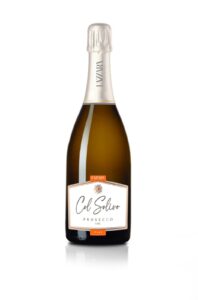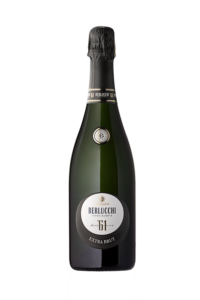Confused on the major differences between all of those sparkling wines out there? From Prosecco to Champagne, things can get a little convoluted for the average drinker. From production methods, sparkling wine types and sweetness levels, we’re here to help you get all that tricky terminology down and help you become a sparkling wine expert just in time for the holidays, and give you some great alternatives to that pricey bottle of champagne.
Production Methods:
There are two main ways to produce sparkling wine: The Traditional Method or the Tank Method. The main difference between these two methods is that the Traditional Method has second fermentation in the bottle, whereas the Tank Method has second fermentation in the tank, which allows a more affordable way of producing sparkling wine.
#1: Traditional Method
A.k.a. Classic Method, methode classique, Champagne Method, metodo tradizionale
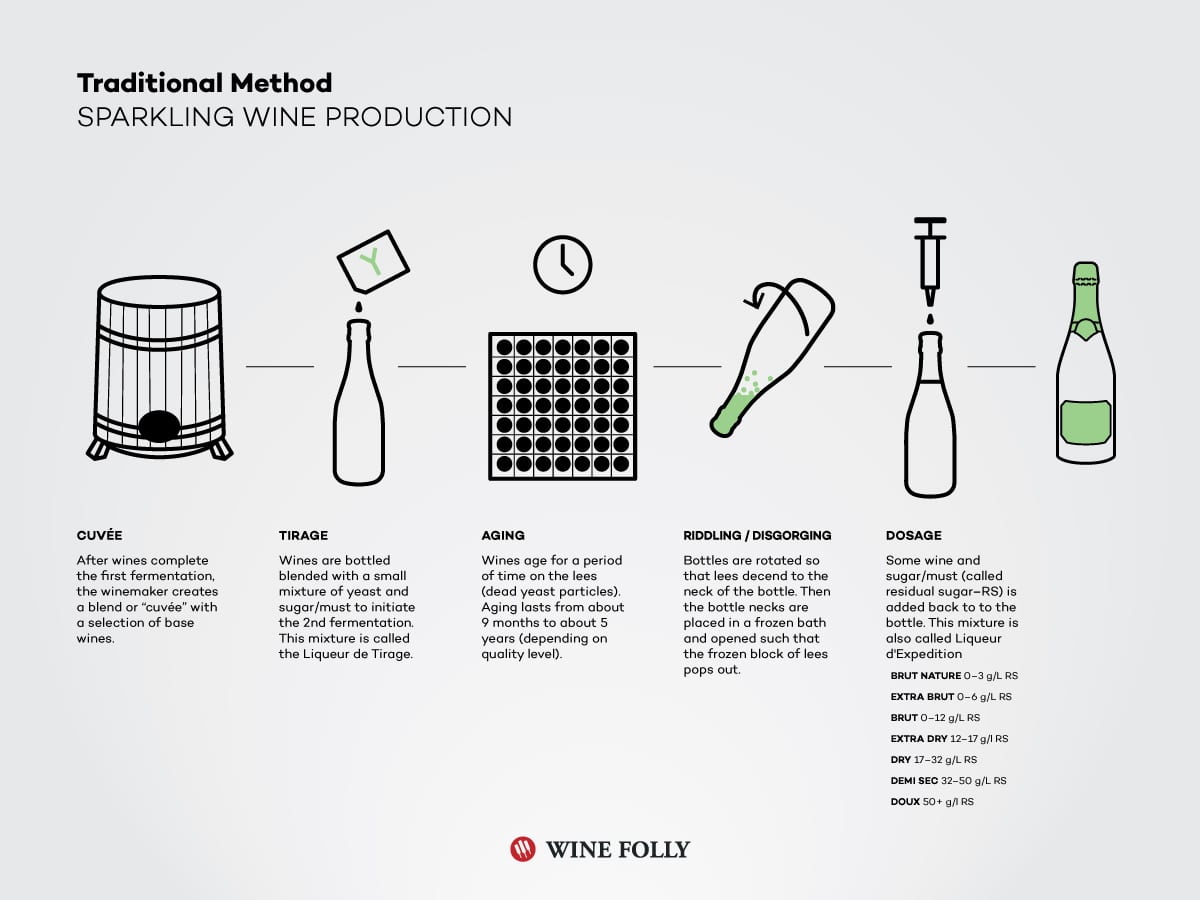 Image courtesy of Wine Folly
Image courtesy of Wine Folly
This method is, without a doubt, the most well regarded method for producing sparkling wine in terms of quality, but it is also the most expensive in terms of production. The classic method’s most crucial feature is that the change from still to sparkling wine takes place entirely inside the bottle, due to a second fermentation.
The process unfolds like this:
First Fermentation: This takes place in large temperature controlled steel vats, but some producers still use oak barrels for some or all of their wine.
Malolactic fermentation: Process where tart malic acid converts into softer lactic acid to soften the acidity and create notes of butter and brioche. This is either triggered or blocked by the producer, depending on the house style and flavor profile they want to achieve. To trigger this, they can either inoculate the bacteria or raise the temperature of the tank. To block it, they can filter, add S02(Sulfur Dioxide) or introduce malolactic-inhibiting enzymes.
Blending: Wine from different vintages, grapes, and vineyard sites is blended to achieve house style despite vintage variations, improve balance, and enhance complexity.
Second Fermentation: The wine is bottled and second alcoholic fermentation is triggered by addition of liqueur de tirage to the base wine. This is a mixture of wine, sugar, yeast, yeast nutrients and a clarifying agent. The bottle is closed with a crown cap that includes a plastic insert, like a small cup. The newly introduced yeast feeds on the sugar and nutrients until it consumes them. The bi-product is CO2 (BUBBLES!), and alcohol. Once the yeast runs out of nutrients it dies and deposits at the bottom of the bottle. Here it starts to self decompose in a process called autolysis. Dead yeast cells are called lees, autolysis gives wine very specific flavors called autolytic characters that producers intentionally seek: biscuit, bread dough, brioche, toast, honey, yogurt.
Aging: Bottles are stored horizontally, and left to age for a set amount of time depending on the type of sparkling wine, Champagne requiring 15 months minimum and Cava requires 6 months minimum.
Riddling: Setting the bottle upside down and the dead yeast cells collect in the neck of the bottle.
Disgorgement: Once riddling is complete, the neck of the bottle is submerged in a very cold solution so that the lees collected in the cap freeze. The bottles are then inverted into a normal upright position while the frozen sediment stays in place, keeping the wine clear. The crown cap is removed and the pressure created in the bottle by the CO2 ejects the lees sediment and part of the wine. Because some wine is lost during this process, the producer adds liqueur d’expedition: a mixture of wine and sugar. The amount of sugar used is called dosage and will determine the final style and sweetness level of the wine. Want to see it in action? Check out this fun video of manual disgorgement here!
#2: Tank Method
A.k.a. Charmat Method, Martinotti Method, Metodo Italiano
The tank method was developed during the early twentieth century’s industrial revolutions and is the primary method for producing Prosecco and Lambrusco wines. The elimination of the individual bottle as the vessel used to transform a still wine into a sparkling wine is the main difference between the tank method and the traditional method. Instead, base wines and the sugar and yeast combination (Tirage) are combined in a huge tank. The CO2 generated after the second fermentation enables the tank to pressurize, allowing the wines to be filtered, dosed (with Expedition liqueur), and bottled without aging.
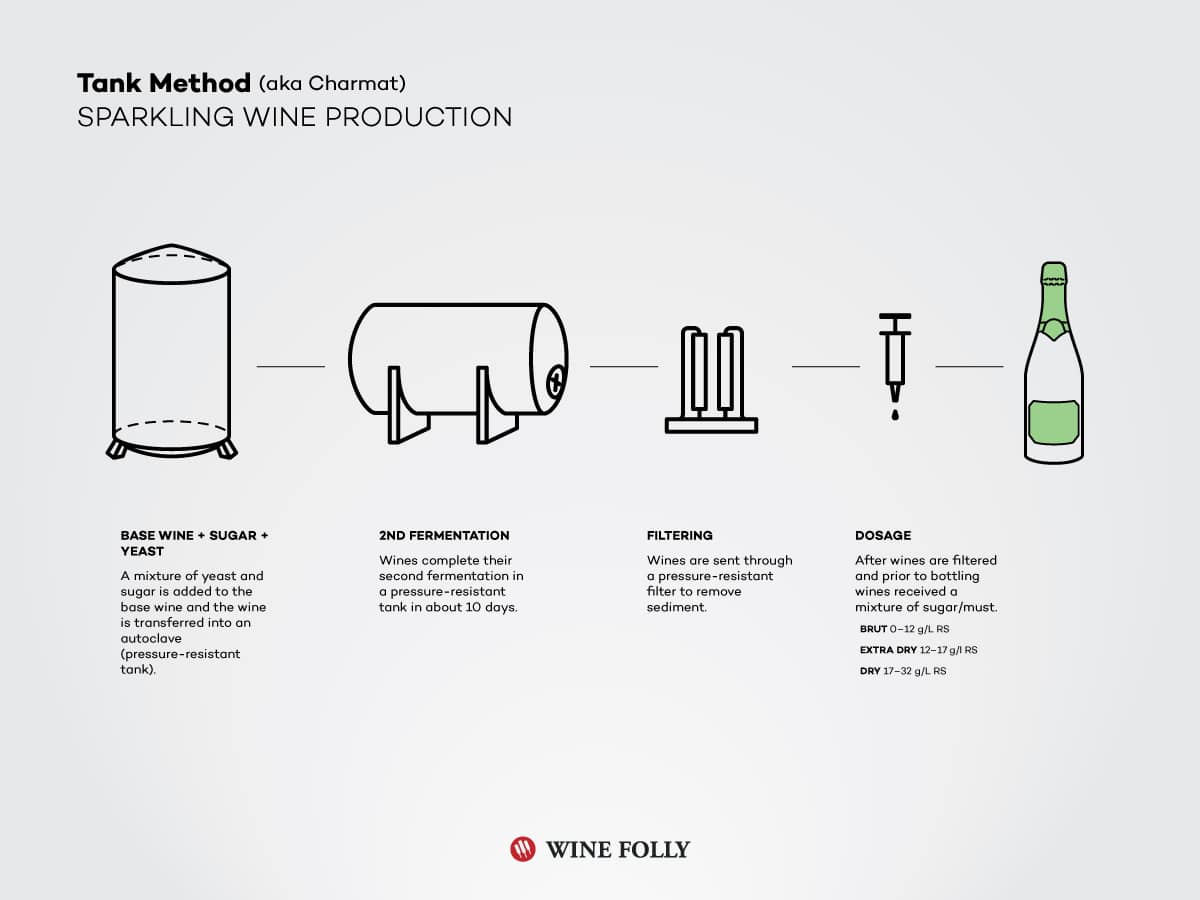
Image courtesy of Wine Folly
Sweetness Level:
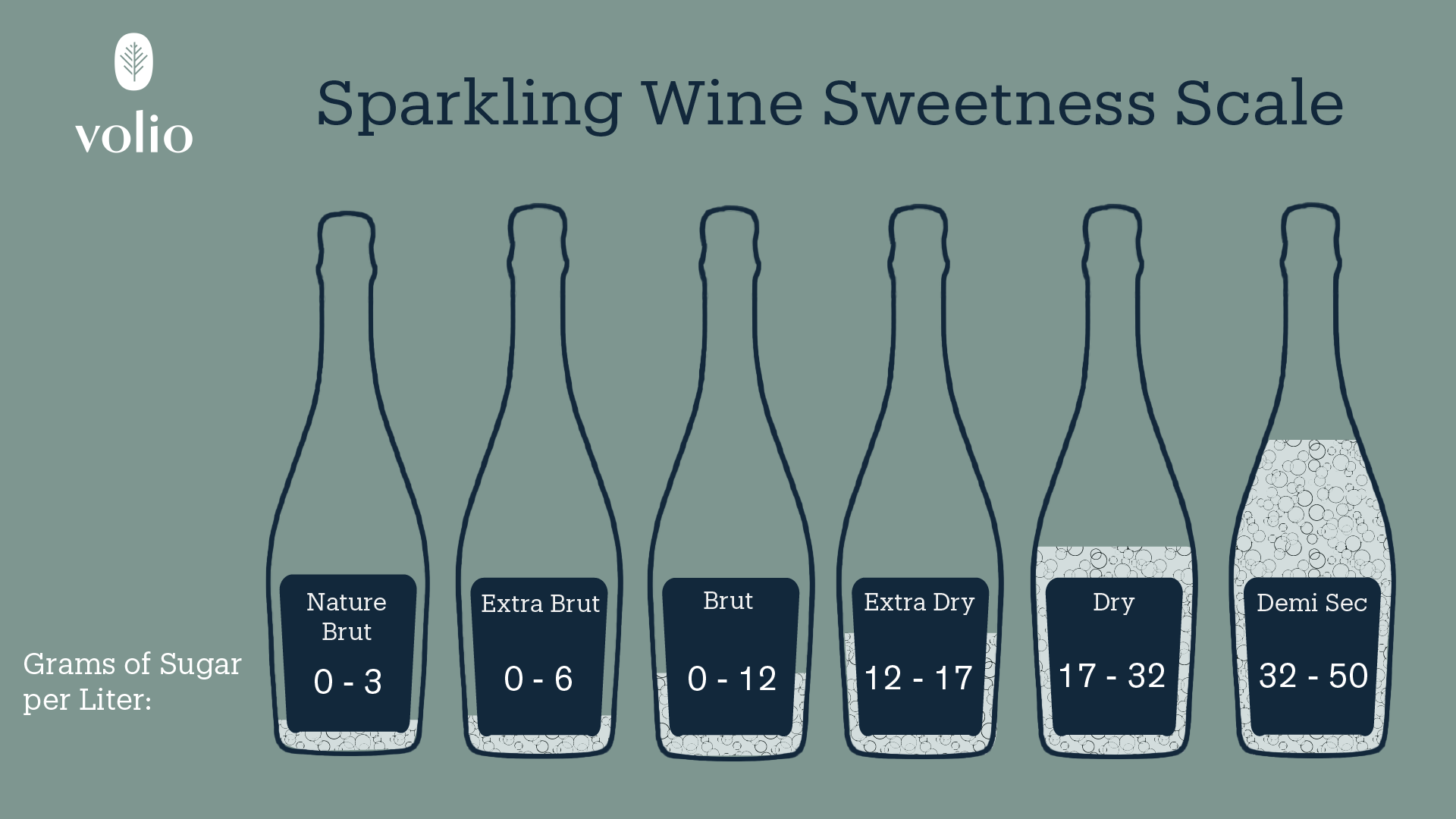
Producers can control the sweetness level of a wine by how sweet the Expedition Liquor is that they add to the fermented sparkling wine. Nature Brut represents the bone dry sparkling wine, all the way to Demi Sec, which begins to approach dessert wine territory.
Common Types of Sparkling Wines:
Prosecco
Created using the tank method, Prosecco is an Italian sparkling wine that is produced in the Veneto region. Prosecco is created using the Glera grape varietal and produces wine that varies from Extra Dry to Brut, but many attribute a higher level of sweetness to this type of wine due to its inherent flavors of green apple, honeydew melon, pear, and honeysuckle.
This sparkling wine can be a great bang for your buck, and the price range for Prosecco can offer great flexibility! $12-$20 is the average range you’ll see for Prosecco.
Franciacorta
The lesser known Italian sparkling wine, Franciacorta, is produced in the small wine producing region of Lombardy in the traditional method (Or in Italian, “metodo classico”). While not as popular as Prosecco, Franciacorta is widely regarded as Italy’s finest sparkling wine.
Created in the same fashion as France’s Champagne, Franciacorta differs from Champagne in two major ways: history and scale. Franciacorta’s history dates back only around 50 years, while Champagne has been around closer to 350 years. Franciacorta’s annual production is around 27,000 hectoliters; Champagne’s is closer to 2,700,00 hectoliter (100 times as much). Small production volumes coupled with the rigorous standards of a DOCG classification justify the relatively high price tag for this sparkling wine.
In 1961, the Berlucchi winery made the first sparkling wine to bear the name Franciacorta. Other producers swiftly followed suit, and the style quickly evolved. The Franciacorta DOC was established in 1967 to encompass both sparkling and non-sparkling wines produced in the region, with the sparkling wines earning DOCG status in 1995.
Created from Chardonnay and Pinot Nero, this fruity sparkling wine pairs well with soft ripened cheeses (like brie), dried fruits (like apricot and cherry), and roasted salted nuts.
Ranging around $35-$65, Franciacorta is a great option to get premium bubbles for a more approachable price than Champagne (and you can scale up to around $100 if you’re looking for a vintaged Franciacorta). Options all around!
Cava
Cava is the most famous sparkling wine originating from Spain. To be classified as a Cava, the wine needs to be produced in one of six specific appellations, and follow the fermentation process of the traditional method, with the secondary fermentation occurs within the bottle. These wines are typically made with the Pinot Noir, Chardonnay, and Parellada grapes, and are usually on the lower end of the spectrum in regards to sweetness.
If you’re looking for sparkling wine that doesn’t break the bank, Cava is an excellent choice, typically ranging from $10 to $20 per bottle.
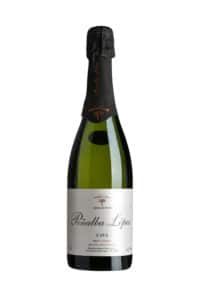 Finca Torremilanos Cava Brut Nature
Finca Torremilanos Cava Brut Nature
Champagne
The most famous sparkling wine, Champagne’s history dates back 100’s of years. Originally, bubbles in wine were seen as a defect, when wine was bottled prior to the fermentation process being completed. Legend has it that French monk Dom Perignon accidentally discovered this process after opening a bottle of wine that wasn’t fully fermented before bottling. He proclaimed to his fellow monks that he was “Drinking the stars!” and sought to make every glass of wine sparkling. While this has been historically disputed, it made for a great story to help spread this new type of wine across Europe.
It wasn’t until the process was standardized and mass marketed that this wine became a luxury produced from the region. A decent-quality bottle of it can cost you anywhere from $50 to $300, and vintage bottles often sell for thousands, making other sparkling wines a much cheaper alternative.
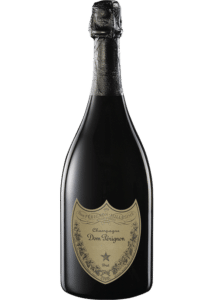 Dom Perignon Vintage Champagne
Dom Perignon Vintage Champagne
Lambrusco
Lambrusco is an Italian red wine that is slightly sparkling (frizzante) and has Etruscan and Roman origins. Lambrusco is also the name of the grape that is used to make the wine, and there are over 60 varieties of the grape known. However, it is usually made from just six: Lambrusco Maestri, Lambrusco Marani, Lambrusco Montericco, Lambrusco Salamino, and Lambrusco Sorbara. Lambrusco is made in northern Italy, mostly in the Emilia-Romagna region. The grapes are farmed in four separate zones: Modena, Parma, Reggio-Emilia, and Mantua, the latter of which is in Lombardy.
The Tank Method (Charmat or Martinotti) technique, which is also used to make Prosecco, is most usually employed to make Lambrusco wines in a somewhat sparkling (frizzante) style. Lambrusco is another great alternative for those wishing to save money, with many options under $10!
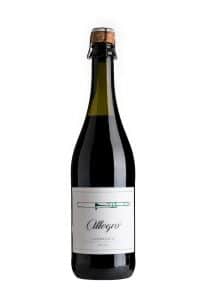 Fratelli Ottoni Lambrusco Secco Allegro
Fratelli Ottoni Lambrusco Secco Allegro
Conclusion:
Champagne is not your only option when it comes to sparkling wine, now you can impress your friends by busting out one of these fine alternatives (without letting them know what a bargain you got for them) and woo them with your production knowledge and terminology.
